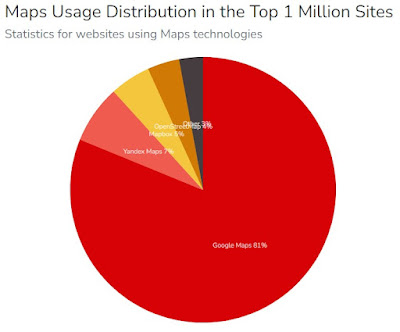Yandex Maps is an online mapping service provided by the Russian technology company Yandex. It offers detailed maps, satellite imagery, and route planning capabilities for various regions around the world. Yandex Maps operates similarly to other popular mapping services like Google Maps.
Yandex Maps has been gaining market share for several reasons:
Strong presence in Russia: Yandex is the dominant search engine in Russia and has a significant user base in the country. This popularity translates to an increased usage of Yandex Maps as well.
Localization: Yandex Maps provides detailed maps and navigation services specifically tailored for Russian users, including accurate information about traffic conditions, public transportation, and points of interest. This localized approach has helped Yandex Maps gain a competitive edge in the Russian market.
Integration with other Yandex services: Yandex Maps is integrated with other popular Yandex services, such as Yandex.Taxi (ride-hailing service) and Yandex.Metro (public transportation navigation). This integration creates a seamless user experience and encourages users to rely on Yandex Maps for various purposes.
Continuous development and innovation: Yandex has been actively improving its mapping service by adding new features and enhancing its capabilities. They have invested in technologies like computer vision and machine learning to improve map accuracy, traffic prediction, and route optimization. These ongoing developments have attracted users and contributed to the increasing market share of Yandex Maps.
While Yandex Maps is particularly popular in Russia, it may face stronger competition in other regions where established mapping services like Google Maps have a significant market presence.
How is Yandex maps being used?
Yandex Maps is used by individuals and businesses for various purposes, including:
Navigation: Users rely on Yandex Maps for turn-by-turn navigation and route planning. It provides detailed directions for driving, walking, and public transportation, taking into account traffic conditions, road closures, and alternative routes.
Local Search: Yandex Maps allows users to search for specific addresses, businesses, landmarks, and points of interest. Users can find information such as contact details, customer reviews, photos, and operating hours for various establishments.
Traffic Information: Yandex Maps provides real-time traffic updates, helping users avoid congested areas and choose the most efficient routes. It displays traffic flow, incidents, and estimated travel times, allowing users to make informed decisions about their journeys.
Public Transportation: Yandex Maps offers information about public transportation systems, including bus, metro, tram, and train routes. Users can plan their trips, view schedules, and access information on fares, transfers, and station locations.
Satellite Imagery: Yandex Maps provides high-resolution satellite imagery, allowing users to explore locations from an aerial perspective. This feature can be useful for understanding the layout of an area, identifying landmarks, or getting a visual overview of a specific place.
Integration with Yandex Services: Yandex Maps integrates with other Yandex services, such as Yandex.Taxi (ride-hailing service) and Yandex.Metro (public transportation navigation). This integration enables users to seamlessly transition from map navigation to booking a ride or planning a public transportation journey.
Business Applications: Businesses can utilize Yandex Maps to showcase their locations, attract customers, and improve their online presence. They can add their establishments to the map, provide accurate contact information, and engage with user reviews and ratings.
Websites using Yandex Maps Yandex Maps
Many websites and applications utilize Yandex Maps for incorporating mapping and location-based services into their platforms. While I can't provide an exhaustive list of all websites that use Yandex Maps, here are a few examples:
Yandex's own websites: Yandex Maps is prominently used on various Yandex-owned websites, such as Yandex.ru (Yandex's search engine), Yandex.Taxi (ride-hailing service), and Yandex.Metro (public transportation navigation).
Local business directories and services: Numerous websites in Russia and neighboring countries use Yandex Maps to display locations, contact information, and user reviews of businesses. Examples include 2GIS, an online business directory, and Yell.ru, a Russian yellow pages service.
Real estate and property listing websites: Websites that feature property listings often integrate Yandex Maps to display the location and provide interactive maps for users. Domofond.ru, a popular Russian real estate platform, is an example of a website using Yandex Maps for this purpose.
Travel and tourism websites: Travel-related websites leverage Yandex Maps to showcase points of interest, attractions, hotels, and routes for travelers. Tutu.ru, a Russian travel platform specializing in train and bus tickets, uses Yandex Maps to display station locations and travel routes.
Delivery and logistics services: Yandex Maps is integrated into various delivery and logistics platforms to optimize routes, track shipments, and provide real-time location information. For example, Yandex.Delivery, a service that offers courier delivery, uses Yandex Maps for route planning.
These are just a few examples, and Yandex Maps is used in a wide range of industries and applications beyond these categories. Its usage is particularly prominent in Russia and other countries where Yandex has a strong presence.



